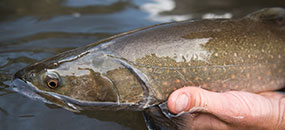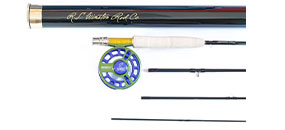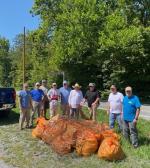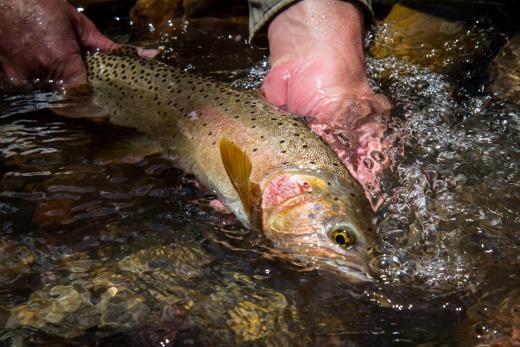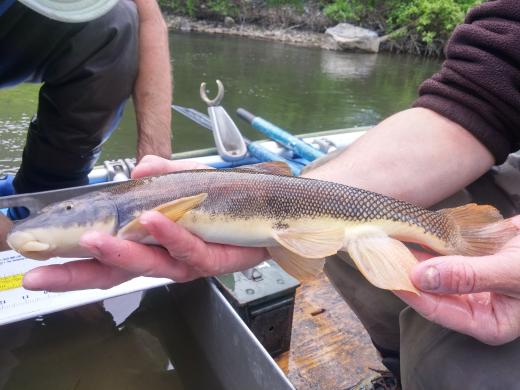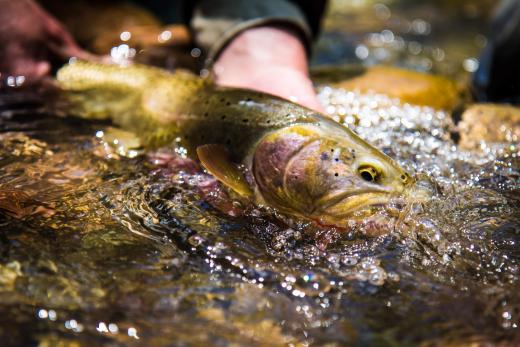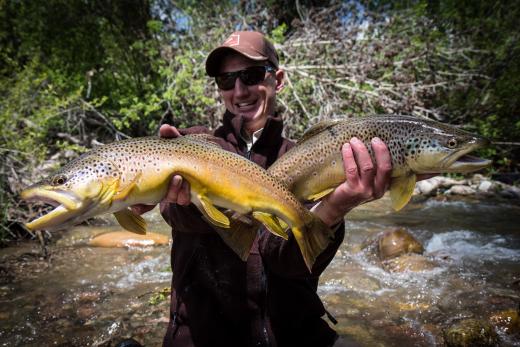Bonneville cutthroat trout are native to the Weber River drainage in northern Utah and are recognized as the state fish of Utah.
By Paul Burnett
Who cares about a sucker? Trout Unlimited does.
The bluehead sucker is a very unique and imperiled species I’m lucky enough to work with on the Weber River in northern Utah.
Predominantly known as a Colorado River species, this fish somehow made a jump into the Bonneville Basin and the upper Snake River thousands of years ago and has developed unique populations.
The bluehead sucker is a unique native fish in Utah's Weber River.
One such population resides in this tributary to the Great Salt Lake, a home river for more than 1,000 TU members living along the Wasatch Front.
Swimming in the Weber alongside the bluehead sucker is the state fish of Utah – the Bonneville cutthroat trout.
Bonneville cutthroat trout are native to the Weber River in northern Utah.
These two native species have held on in the Weber despite a long history of human caused abuse in and along the river.
Several partners have been working to help the native fish maintain vibrant populations in the Weber. A new video “Blueheads and Bonnevilles” highlights these efforts.
Not long after western expansion into Utah, many of the tributaries and even the Weber River itself were heavily diverted for agricultural water use. As progress marched on, flood control and roads had their impacts on the river. One example of this damage is a place known as Henefer Valley. The river was straightened to make way for Interstate 84 in this 10-mile long valley, shortening the river by three miles and permanently altering the habitat.
To date, TU staff and our partners – namely the Utah Division of Wildlife Resources - have identified more than 100 miles of impacted habitat and almost 400 fish barriers. Amazingly, the Bonneville cutthroat trout and bluehead sucker have managed to persist through these impacts. Nonnative brown trout have taken hold in the Weber and, while they do impact the native species, have become a popular target for anglers. They will remain an important part of the fishery.
Nonnative brown trout are a popular target for anglers on the Weber River and will remain a part of the fishery.
The cutthroat trout have mostly been relegated to headwaters, but recent restoration efforts are bringing this species back in the main stem of the Weber, where they grow large and are popular for anglers.
The bluehead sucker has been impacted by habitat fragmentation and serves as an important bellwether of the river. Bluehead sucker need cool, complex mainstem river habitat, much of which has been lost in the Weber. This is also the habitat needed to produce large cutthroat trout.
Extensive collaboration is needed to make the kind of restoration efforts required to keep cutthroat trout and bluehead sucker as residents of the Weber drainage. A large majority of the land along the Weber River is on private land. Major Bureau or Reclamation projects control flow in much of the river and 220 small irrigation diversions subtract water for a multitude of uses. Each landowner, each water user, each municipality and each agency have a unique value set that doesn't necessarily align with Trout Unlimited’s.
Electroshocking is an important tool used to monitor populations of all species in the Weber River.
Beyond the habitat restoration and reconnect work TU is involved with, we also played an integral role in the formation of the Weber River Partnership. The goal of the partnership is to bring together the diverse interests within the watershed to find solutions to the complex challenges in the watershed.
Some challenges include: increasing fish populations; more water use; legacy affects of habitat loss; and extensive habit fragmentation.
There are not any easy solutions, but we all have a much better chance of finding solutions if people talk to each other. And that's what we are doing. It's not easy, but this increased collaboration has led to very positive outcomes.
For example, non-traditional partners like the Weber Basin Water Conservancy District have made significant financial contributions for research on bluehead sucker and Bonneville cutthroat trout and also to our reconnect projects.
The partnership within the Weber River has also drawn the attention of the Western Native Trout Initiative and the Desert Fish Habitat Partnership. These habitat partnerships have been long term partners with TU and they have teamed up on the “Blueheads and Bonnevilles” campaign. We were lucky to participate in their fantastic video documenting our collaborative efforts in the Weber.
We are hopeful that things are looking up for the Weber. There is a lot of work still to be done, but through partnerships involving TU staff and hundreds of dedicated members in the Weber Basin Anglers and the High Country Flyfishers chapters we are confident we can continue bringing these fisheries back!
Please support the Blueheads and Bonnevilles campaign on the Western Native Trout Initiative’s crowdrise page. This is a chance to tap into the power of numbers to make fishing better on the Weber River and throughout the West. With many partners through small contributions we believe we can increase our collective impact to our rivers.
Funds raised through the crowdrise site will be contributed to two specific projects on the Weber River, the removal of a small dam in the Weber River and re-establishment of fish passage on a tributary to the lower Weber River called Jacobs Creek.
We continue our efforts to reconnect habitats, both in the Weber River and its tributaries to improve the resiliency of our important native fish. As an incentive for this fundraiser, Trout Unlimited has donated a Redington Butterstick 4-weight fly rod with matching Redington Drift Reel. Perfect for landing cutts in small streams, and guaranteed not to get lost in the brush.
Paul Burnett is the Utah Project Leader for Trout Unlimited. He can be reached at pburnett@tu.org


